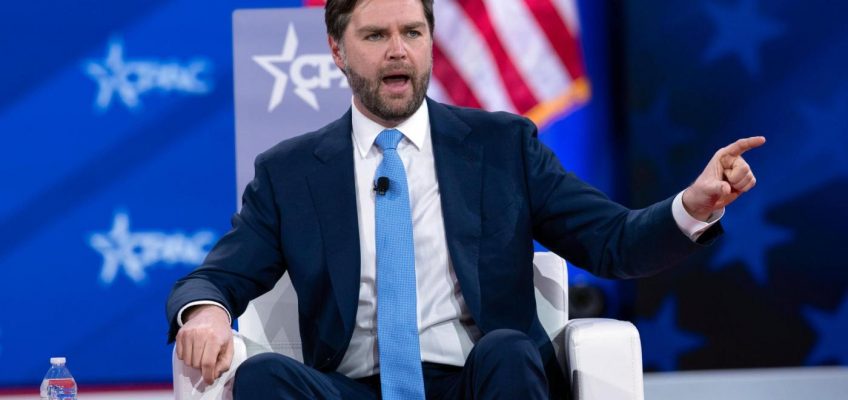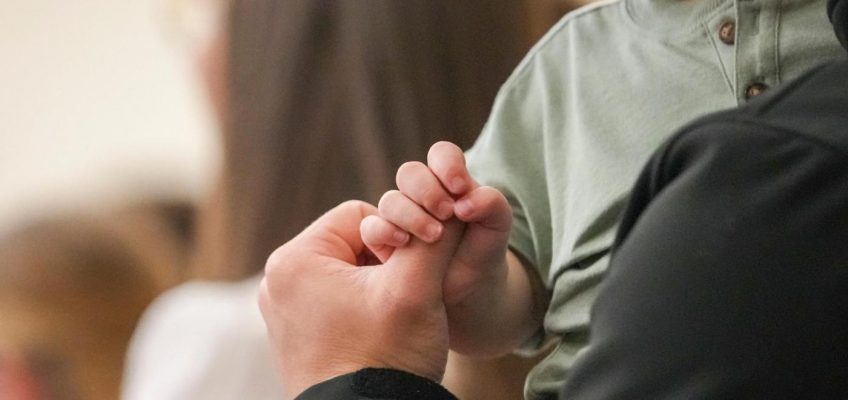By DEVI SHASTRI, Associated Press and CARLOS NOGUERAS RAMOS, Texas Tribune
SEMINOLE, Texas (AP) — Measles had struck this West Texas town, sickening dozens of children, but at the Community Church of Seminole, more than 350 worshippers gathered for a Sunday service. Sitting elbow-to-elbow, they filled the pews, siblings in matching button-down shirts and dresses, little girls’ hair tied neatly into pink bows.
Fathers shushed babbling toddlers as their wives snuck out to change infants’ diapers.
A little girl in this mostly Mennonite congregation was among those who’d fallen ill with the highly contagious respiratory disease, senior pastor David Klassen said — but she’s doing fine, and she happily played through her quarantine. He heard that at least two Mennonite schools shut down for a bit to disinfect.
A woman wearing traditional clothing seen in the Mennonite community carries a child while taking a seat during a service at Community Church of Seminole, Sunday, Feb. 23, 2025, in Seminole, Texas. (AP Photo/Julio Cortez)
What he hasn’t heard: Any direct outreach from public health officials on what to do as the number of those sickened with measles has grown to 146 and a school-age child has died. And though Klassen is a trusted church and community leader, his congregants haven’t asked about whether they should vaccinate their kids — and he wouldn’t want to weigh in.
“With this measles situation, I can honestly just tell you we haven’t taken any steps as a church,” he said. “We did leave it up to the mothers.”
As measles — a preventable disease the U.S. considered eliminated in 2000 — spreads through West Texas’ rural expanse, Klassen is sticking to an approach on vaccines that is a key tenet for Mennonites. Family leaders are the top decision-making authority — not outside recommendations, certainly not government mandates.
Alongside measles in this region, where voters overwhelmingly supported President Donald Trump, there’s another outbreak: one of misinformation about vaccines, distrust of local public health officials and fear of governmental authority overruling family autonomy. And on the national stage, Robert F. Kennedy Jr., the country’s top health official and an anti-vaccine activist, dismissed the Texas outbreak as “not unusual.”
“Do I trust all the vaccines? No,” Klassen said. “And I get from (Kennedy) that he doesn’t trust all the vaccines, either. And he is very well educated in that; I’m not.”
In an opinion piece for Fox News Digital, Kennedy wrote about the value of the vaccine but stopped short of calling on families to get it, saying the decision is “a personal one.” He urged parents to speak to their health care providers about options.
Vaccine skepticism has also been spurred by state lawmakers who this year filed more than a dozen bills that would strengthen or expand vaccine exemptions, which Texas already allows for “reasons of conscience, including a religious belief.”
Doctors on the front lines
At hospitals in Lubbock, 80 miles to the north and on the front lines of the outbreak, babies with measles are struggling to breathe.
Dr. Summer Davies, a Texas Tech Physicians pediatrician, said she has treated about 10 of the outbreak’s patients, most very young or teens. She said children have had to be intubated, including one younger than 6 months old. Others come in with such high fevers or severe sore throats that they refuse to eat or drink to the point of dehydration.
FILE – A health worker administers a measles test on Fernando Tarin, of Seagraves, Texas, at a mobile testing site outside Seminole Hospital District, Friday, Feb. 21, 2025, in Seminole, Texas. (AP Photo/Julio Cortez, File)
“It’s hard as a pediatrician, knowing that we have a way to prevent this and prevent kids from suffering and even death,” she said. “But I do agree that the herd immunity that we have established in the past isn’t the same now. And I think kids are suffering because of that.”
In Lubbock County, 92% of kindergarteners are up to date on their measles, mumps and rubella shots, according to the Texas Department of State Health Services. That’s lower than the 95% threshold experts say is needed to prevent measles from spreading. Gaines County, which includes Seminole, has an 82% MMR vaccination rate, though rates for homeschooled or private school students may be much lower. The vaccine series is required for kids before entering kindergarten in public schools nationwide. Many Mennonite families don’t send children to public schools.
All of the children admitted with measles to Covenant Children’s Hospital in Lubbock were unvaccinated, officials said last week. Dr. Lara Johnson, the hospital’s chief medical officer, told The Associated Press that Covenant has seen more than 20 patients, including children, teens and pregnant mothers, since the outbreak began in late January.
News of a measles case in Seminole, population 7,200, put doctors on a “shared high alert,” said Dr. Martin Ortega, a family physician for Texas Tech Physicians in Odessa, about an hour away. The small towns of West Texas may look completely isolated on a map, with little between them beyond oil and gas facilities and sprawling desert. But the region is connected by its people, who regularly travel long distances to grocery stores, hospitals and houses of worship.
Many doctors are seeing measles cases for the first time in their careers. In Lea County, New Mexico, 30 minutes west of Seminole, nine measles cases with no clear connection to the Texas outbreak, rattled doctors and parents. An unvaccinated infant in Austin also tested positive for measles after an overseas vacation.
It’s “a little bit surreal,” said Dr. Rumbidzai Mutikani, a pediatrician at Nor-Lea Hospital District’s Hobbs Medical Clinic. Parents were so concerned “our phones were just ringing,” Mutikani said.
Katherine Wells, director of Lubbock’s public health department, said West Texas’ rural landscape is a major challenge, not just in getting to patients and transporting test samples, but also in getting the word out.
A lot of the messaging is word of mouth, she said, but they are working on public-service announcements featuring trusted Gaines County residents, putting up billboards about measles, handing out flyers and posting in WhatsApp groups.
The COVID-19 pandemic caused “a lot of distrust in public health” and government requirements, Wells said. On Facebook, people have accused her of making up the measles outbreak. They hope her department loses its funding.
It’s “really hurtful stuff,” she said. “We’re really working to help encourage vaccines for our community and help those kids that are infected to make sure they get medical treatment so that we don’t end up with another death.”
Pro-Trump, but ‘not anti-vaxxer’
The reality on the ground can be nuanced, however.
Brownfield Mayor Eric Horton is pro-Trump, he said, but also pro-MMR vaccine.
His county was hard-hit by COVID-19, Horton said, with nearly 90 deaths. So when measles cases came to his town of 8,600, Horton feared for his community. He said the local hospital has been busy administering vaccines since the outbreak started.
“Out here on the south plains of Texas, we are conservative people, but we also are not anti-vaxxers,” he said.
Across the region, people echoed this sentiment about routine childhood vaccinations in interviews with the AP and The Texas Tribune. Often, though, they are less supportive of COVID-19 and flu shots.
“It’s frustrating that (Mennonites) don’t vaccinate, and they put other people’s families and children at exposure for it,” said Stephen Spruill, a 36-year-old trucker from Seminole.
But “this is America. People have the right to choose.”
Macey Lane, 31, of Hobbs, said: “I do support Donald Trump. I don’t support not requiring vaccines.”
All of Lane’s kids are vaccinated. Praising Sen. Mitch McConnell’s vote against Kennedy’s nomination, she said the fact that “the only Republican that went against RFK was a polio survivor says a lot.” But she said she voted off other issues: her religious beliefs, stance on abortion and who would be best for the region’s oil and gas industry.
“As far as RFK being an anti-vaxxer, this is the most important thing: People have to make a decision for themselves and be as informed as they possibly can,” Horton said.
But in doctors’ offices throughout the region, pediatricians see the consequences of that stance.
Mutikani, the Hobbs pediatrician, said she’s seen vaccine hesitancy increase in recent years as parents come to her with worries that line up with what’s trending on social media. “Virulent” misinformation is especially worrisome in rural areas with few news sources or where many people who don’t regularly see doctors live, she said.
And having “these really big, respected public figures openly going against the grain, going against research and what we know, it makes it really, really difficult,” she said.
Most Texans are still vaccinating their kids, including Jennifer Sanchez, a 26-year-old Odessa resident. She took her 6-year-old and 1-year-old to the local public health department last week to get the measles vaccine.
She is disinfecting her house out of an abundance of caution, wishing she had more information on how to stop the spread.
“The government needs to give us more tools so we can protect ourselves,” she said.
AP journalists Mary Conlon and Julio Cortez contributed to this report.
This story is part of a collaboration between The Texas Tribune, a nonprofit newsroom dedicated to promoting civic engagement, and The Associated Press. The Associated Press Health and Science Department receives support from the Howard Hughes Medical Institute’s Science and Educational Media Group and the Robert Wood Johnson Foundation.




